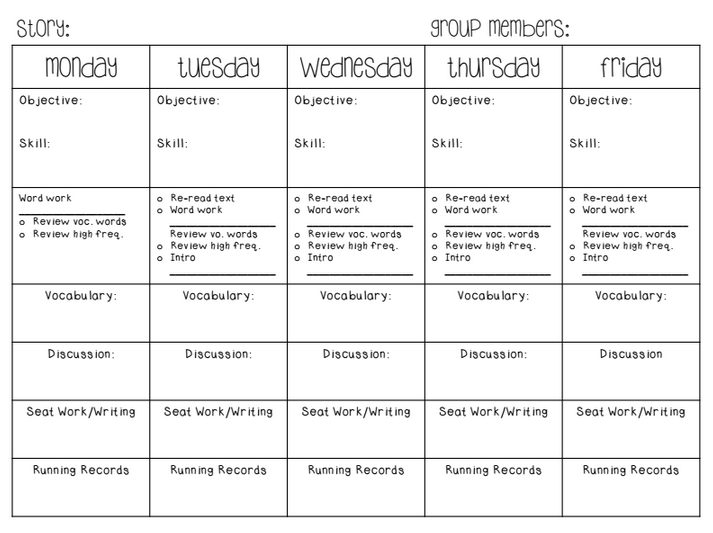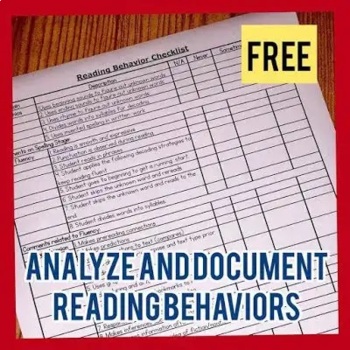Welcome to another week of Tipster Thursday here at I Teach Second. I am Carla from Comprehension Connection, dropping by to share tips on making your guided reading groups run like a well oiled machine. After all, learning to read is one of the best gifts we can give our students, and in order to get the most out of a reading group, the teacher must be organized. I have five tips to for you to ponder (and a few freebies throughout). Consider what Michael Stutman says on Inspire My Kids for a minute first.
Tip #1-Organize your Students
 All of our students come from differing levels of organization at home, and therefore, they need to be taught procedures and expectations in order to implement them on their own. If you have a schedule that is predictable and your room is set up for good flow, then students will be able to work in a more efficient manner. As you set up your room, consider the activity level of your students, how you plan for them to work (independently, pairs, or groups), how you will transition to/from groups and centers, and honestly, what you have for furniture. If you are a novice teacher, you get
All of our students come from differing levels of organization at home, and therefore, they need to be taught procedures and expectations in order to implement them on their own. If you have a schedule that is predictable and your room is set up for good flow, then students will be able to work in a more efficient manner. As you set up your room, consider the activity level of your students, how you plan for them to work (independently, pairs, or groups), how you will transition to/from groups and centers, and honestly, what you have for furniture. If you are a novice teacher, you get
Tip #2-Organize your Materials
 One of the best way to keep all on task is to have everything you need organized and ready right by your reading table. I could not teach without my reading table and "stuff". I have bags of highlighters in six colors ready to distribute for close reading tasks, dry erase boards, markers, and erasers ready for word study, reading notebooks and guided reading books in baskets by group, and all of my other tools in baskets ready to pull as I need. My bloggy buddies Jennie at JD's Rockin Readers and Jessica at Hanging Out in First have done wonderful posts on organizing reader toolkits. You might check out Jennie's Guided Reading Notebook freebie. She explains it in [this post] over at our collaborative blog, Adventures in Literacy Land. Jessica actually put together a thorough post on her toolkit in a post yesterday. Here is the link to that post. Groups need to run like clockwork, and using time to gather supplies means downtime for kids. Downtime equals more time pulling them back in, so keep those materials handy and ready to use. Here are a few pictures from Jennie and Jessica (used with permission of course).
One of the best way to keep all on task is to have everything you need organized and ready right by your reading table. I could not teach without my reading table and "stuff". I have bags of highlighters in six colors ready to distribute for close reading tasks, dry erase boards, markers, and erasers ready for word study, reading notebooks and guided reading books in baskets by group, and all of my other tools in baskets ready to pull as I need. My bloggy buddies Jennie at JD's Rockin Readers and Jessica at Hanging Out in First have done wonderful posts on organizing reader toolkits. You might check out Jennie's Guided Reading Notebook freebie. She explains it in [this post] over at our collaborative blog, Adventures in Literacy Land. Jessica actually put together a thorough post on her toolkit in a post yesterday. Here is the link to that post. Groups need to run like clockwork, and using time to gather supplies means downtime for kids. Downtime equals more time pulling them back in, so keep those materials handy and ready to use. Here are a few pictures from Jennie and Jessica (used with permission of course).
Tip #3-Organize your Groups
 Assessments are the first step in forming reading groups, and being a kid watcher helps you know whether you've got a great match for level. When you see that your kids are reading seamlessly through books, push them up. Kids need a little challenge, but still...keep that oiled machine in mind. Too much will cause breakdown!
Assessments are the first step in forming reading groups, and being a kid watcher helps you know whether you've got a great match for level. When you see that your kids are reading seamlessly through books, push them up. Kids need a little challenge, but still...keep that oiled machine in mind. Too much will cause breakdown!In planning, use a routine to address all reading skills (phonics, fluency, comprehension, vocabulary, and writing about reading). The lesson plan to the right from The Bubbly Blonde is an example of streamlining the routine. [This post] from her blog walks through planning for the transitional reader. Depending on the reading stage, the time allotted to each skill various to the needs of the student. For struggling readers, more time is focused on word building and fluency, whereas, advanced readers would spend the majority of their time on reading comprehension, vocabulary development, and writing.
 [This post] from The Teaching Thief explains well how to organize/track groups. [My post] on analyzing reading behaviors may be helpful to our readers here too. This freebie is a checklist of what to watch for and works well for parent conferences. The video below is from Jennie to help you see how to use your running record data and set up groups. You'll find this very helpful.
[This post] from The Teaching Thief explains well how to organize/track groups. [My post] on analyzing reading behaviors may be helpful to our readers here too. This freebie is a checklist of what to watch for and works well for parent conferences. The video below is from Jennie to help you see how to use your running record data and set up groups. You'll find this very helpful.
Tip #4-Organize your Library
 Can you tell my library is important to me? I have organized by books by theme and author, and my students borrow books any time they need to. I feel so happy having them curled up in my beanbag chairs losing themselves in a good book. I believe one of the best ways to inspire reading is to make if feel warm and fuzzy like a well worn blanky. Even my fourth and fifth grade kids snuggle up with my oversized bear. I highly recommend yard sales...lots and lots of yard sales. Then, talk to parents in your PTO or church to ask them to think of you when they're cleaning out bookshelves. Many are willing to just pass books on to you. What you can't use, may work to send home as prizes.
Can you tell my library is important to me? I have organized by books by theme and author, and my students borrow books any time they need to. I feel so happy having them curled up in my beanbag chairs losing themselves in a good book. I believe one of the best ways to inspire reading is to make if feel warm and fuzzy like a well worn blanky. Even my fourth and fifth grade kids snuggle up with my oversized bear. I highly recommend yard sales...lots and lots of yard sales. Then, talk to parents in your PTO or church to ask them to think of you when they're cleaning out bookshelves. Many are willing to just pass books on to you. What you can't use, may work to send home as prizes.
 Can you tell my library is important to me? I have organized by books by theme and author, and my students borrow books any time they need to. I feel so happy having them curled up in my beanbag chairs losing themselves in a good book. I believe one of the best ways to inspire reading is to make if feel warm and fuzzy like a well worn blanky. Even my fourth and fifth grade kids snuggle up with my oversized bear. I highly recommend yard sales...lots and lots of yard sales. Then, talk to parents in your PTO or church to ask them to think of you when they're cleaning out bookshelves. Many are willing to just pass books on to you. What you can't use, may work to send home as prizes.
Can you tell my library is important to me? I have organized by books by theme and author, and my students borrow books any time they need to. I feel so happy having them curled up in my beanbag chairs losing themselves in a good book. I believe one of the best ways to inspire reading is to make if feel warm and fuzzy like a well worn blanky. Even my fourth and fifth grade kids snuggle up with my oversized bear. I highly recommend yard sales...lots and lots of yard sales. Then, talk to parents in your PTO or church to ask them to think of you when they're cleaning out bookshelves. Many are willing to just pass books on to you. What you can't use, may work to send home as prizes.  For my students, wall space is a huge help and support. I post the anchor charts we use and make together and refer to them all...the...time! As reading vocabulary is taught, I flag it, repeat it often, and send my kids to it to use. My reading test vocabulary product is very helpful this time of year as I prepare my kids for state testing. You can check it out [here]. They are pictured in the top-right corner of the photo. The set on the left side is best for struggling spellers. These phoneme cards can be used as anchor charts, for reference during writing, or for word study lessons. I have several color schemes available.
For my students, wall space is a huge help and support. I post the anchor charts we use and make together and refer to them all...the...time! As reading vocabulary is taught, I flag it, repeat it often, and send my kids to it to use. My reading test vocabulary product is very helpful this time of year as I prepare my kids for state testing. You can check it out [here]. They are pictured in the top-right corner of the photo. The set on the left side is best for struggling spellers. These phoneme cards can be used as anchor charts, for reference during writing, or for word study lessons. I have several color schemes available.
Now, it is your turn. Share a few reading tips that have helped you!
Until next time, happy reading!






Love these tips! Thanks for sharing, Carla!
ReplyDeleteThanks so much! Glad you found it helpful!
Delete